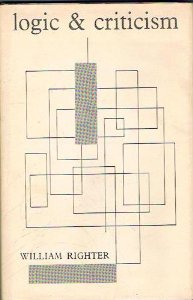Fuse Commentary: Arts, Criticism, and the Search for a Serious Space
Criticism is vital to our time because it is a form of witnessing, testimony to the possibility that the richness and joy of the arts can be articulated in ways that invite intellectual contentiousness in the midst of community.
By Bill Marx.
This year marks the 50th anniversary of one of my favorite works of arts criticism, Logic & Criticism by William Righter, published in 1963. Some of its arguments are pretty dated now, particularly its antique tug-of-war with I. A. Richards about an antique “theory of value.” But what I love about the book is that Righter (1927–1997) doesn’t fulminate over the justice or injustice of specific critical decisions about works of art throughout history, doesn’t wring his hands over why a reviewer was “right” or not. He assumes that even our most revered critics have often gone astray.
Instead, Righter examines the reasons (moral, political, aesthetic, rational, and irrational) that critics have used over time, the various arguments and rhetorical strategies they have drawn on to convince readers that one creative act is more powerful than another, one artist impressive, another overrated. The problem of critical judgment revolves around justification, argues Righter: “All along I have emphasized that the reasons given are usually more important than the judgment itself . . .” Because of our culture’s obsession with commercial success and gossip, we are hung up on snap judgements and consumer guides, but that is the least resonant part of arts criticism. Why we make the judgments we do is as, if not more, important than the directions in which our thumbs swing.
In this sense, criticism becomes a matter of cultural health. When we try to justify our cultural preferences we are forced to make private reactions public, to articulate what we value in the arts in ways that invite serious responses rather than simply sell tickets or score cheap shots. We pay homage to the arts when we carefully express what we care for, what we don’t care for, and give reasons. There is no model approach—criticism is far too idiosyncratic a craft. But some reasons—infused with high style and penetrating insight—are stronger than others. How do we encourage this kind of talk about why we like what we like?
Edith Wharton rightly sees criticism as a human instinct, an elemental appetite. “There is no way of reacting to any phenomenon but by criticizing it,” she argues, “and to differentiate and complicate one’s reactions is an amusement that human intelligence will probably never renounce.” What is at stake for our cultural well-being is whether we care to invest in developing this primal yen in meaningful ways, to make our explanations for what we value in the arts more self-conscious, sophisticated, and pleasurable. The omnipresent language of advertising and marketing flatten reactions, minimizing our conception of artistic experiences rather than conveying their complexity. And in the long run, that reduces the meaning and power of the arts in our lives. Arts criticism should be an educational and inspirational “amusement,” an assertion of the value of discernment in the arts. Criticism is vital to our time because it is a form of witnessing, testimony to the possibility that the richness and joy of the arts can be articulated in ways that invite intellectual contentiousness in the midst of community.

Please help The Arts Fuse get the word out about its substantial arts coverage. Contribute to our latest campaign.
In what ways can the Internet tap into that complex experience, enhance our desire to compare, judge, and discuss in ways that make the arts matter? How will these methods be different from past forms of evaluation? Those are the important questions facing the future of arts criticism, and there are reasons for encouragement as well as fear—with less centralized power comes opportunities for more informative and fearless analysis. There’s also the possibilities for a chaotic and terminal free-for-all.
To me, it is an issue of establishing spaces that encourage (and develop) the desire for justification, an area that is not just about registering judgments but cultivating the need to back up verdicts with solid evidence and analysis. In the future, innovative critics will cultivate our appetite for arts reviews through an interactive marriage of expertise, passion, and technology. Criticism will not be an effusion from a priest on high but a form of stimulus shaped to kick off a fertile “thread” of comments, reactions, and debate. Rainey Knudson, the founder and director of Glasstire, a website about visual art in Texas, put the exciting possibilities for the regeneration of cultural discussion well: “. . . the arts journalism of the near future has the potential to be radically more effective, with far greater reach, than the old print model that has crumbled around us.”
I believe that, which is why I founded The Arts Fuse, an online resource that features expert writing—critical, informative, engaging—on the arts in Boston and the rest of New England. More than 1700 articles—all currently online—have been published. With Fuse News, we are taking another significant step toward our goal of creating an online space where readers will find stimulating news and views about arts and culture. Please support a magazine that does its best to generate discussion rather than consumer tips. Here is where you can make your donation.

